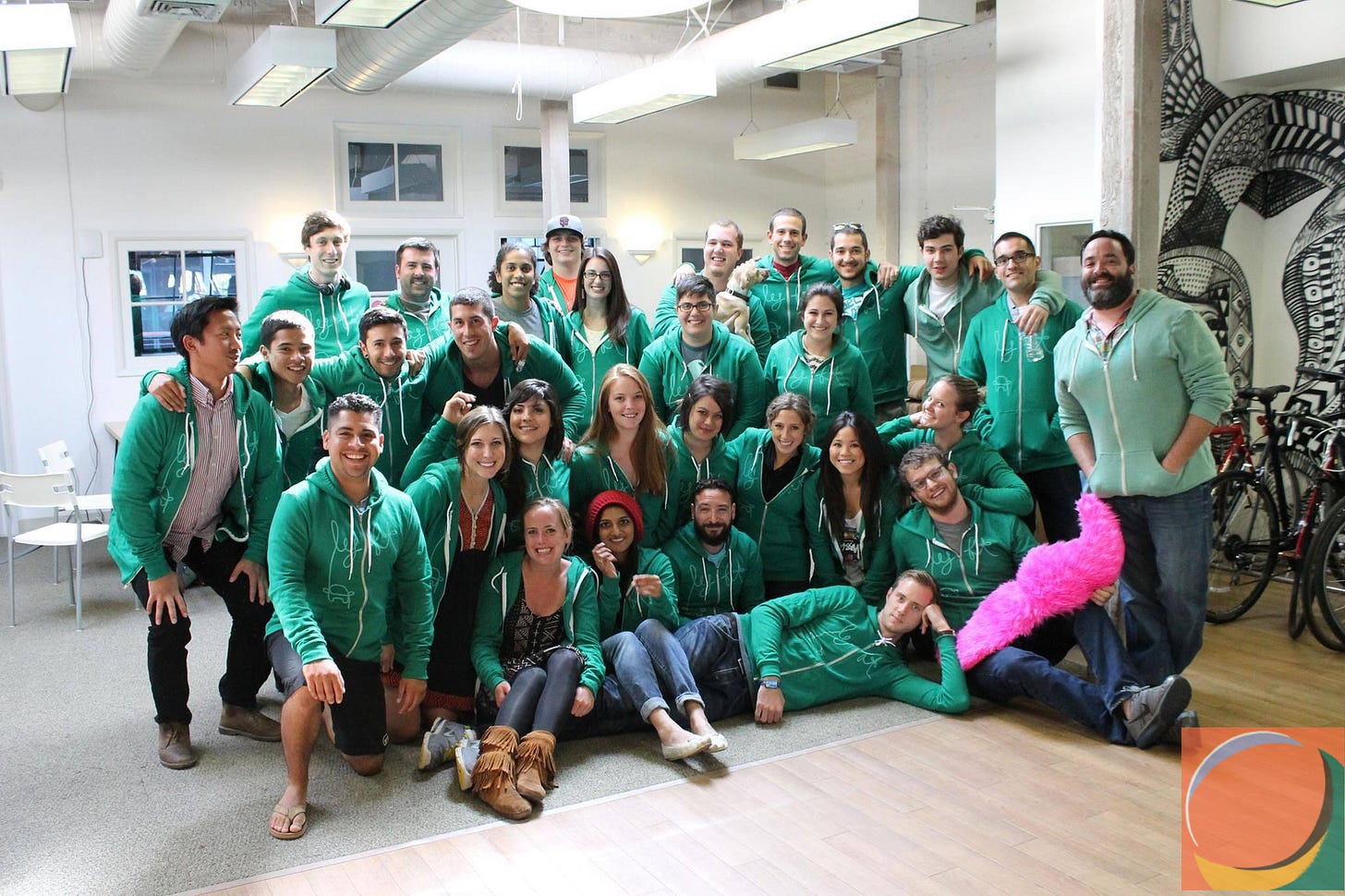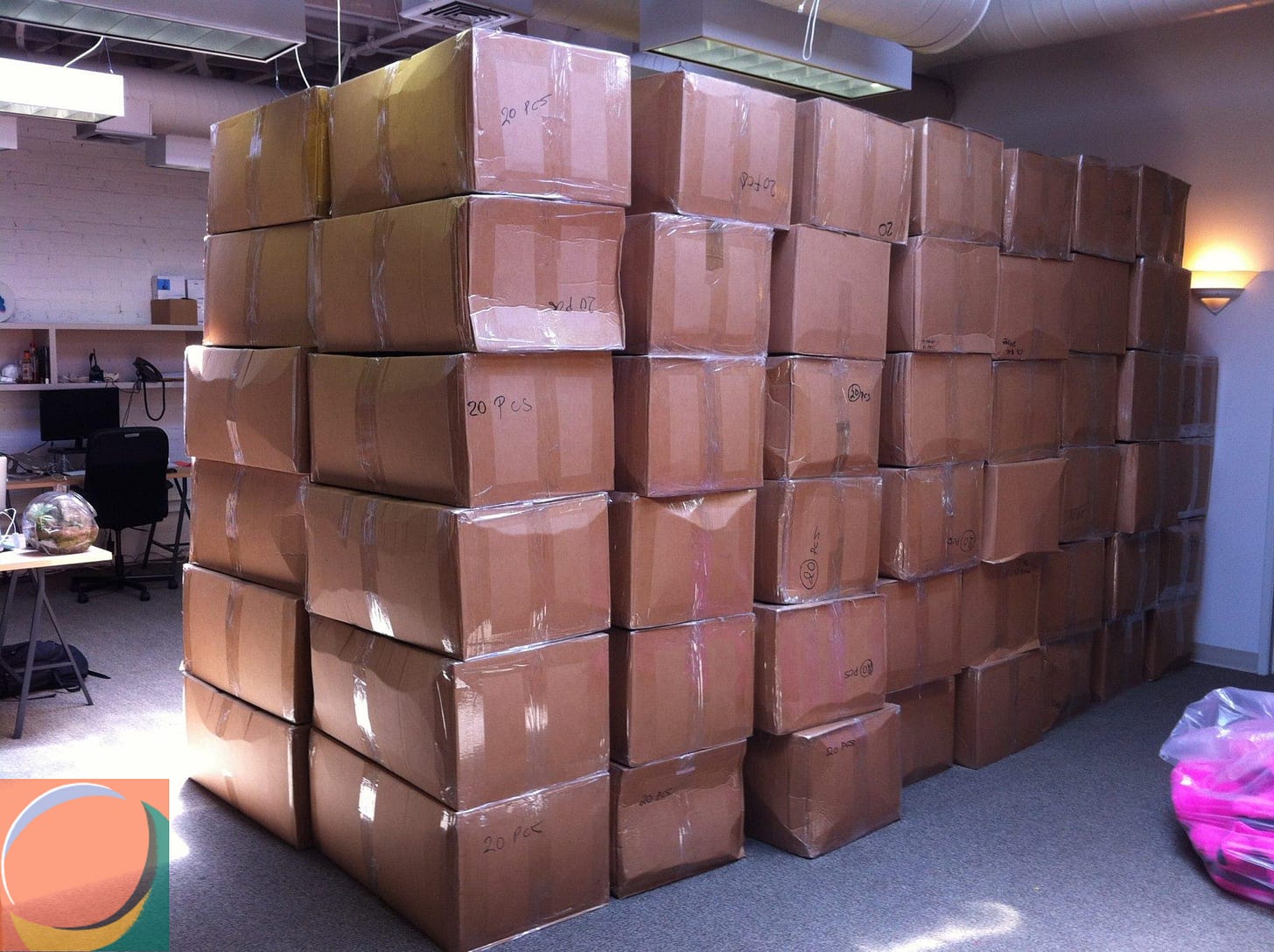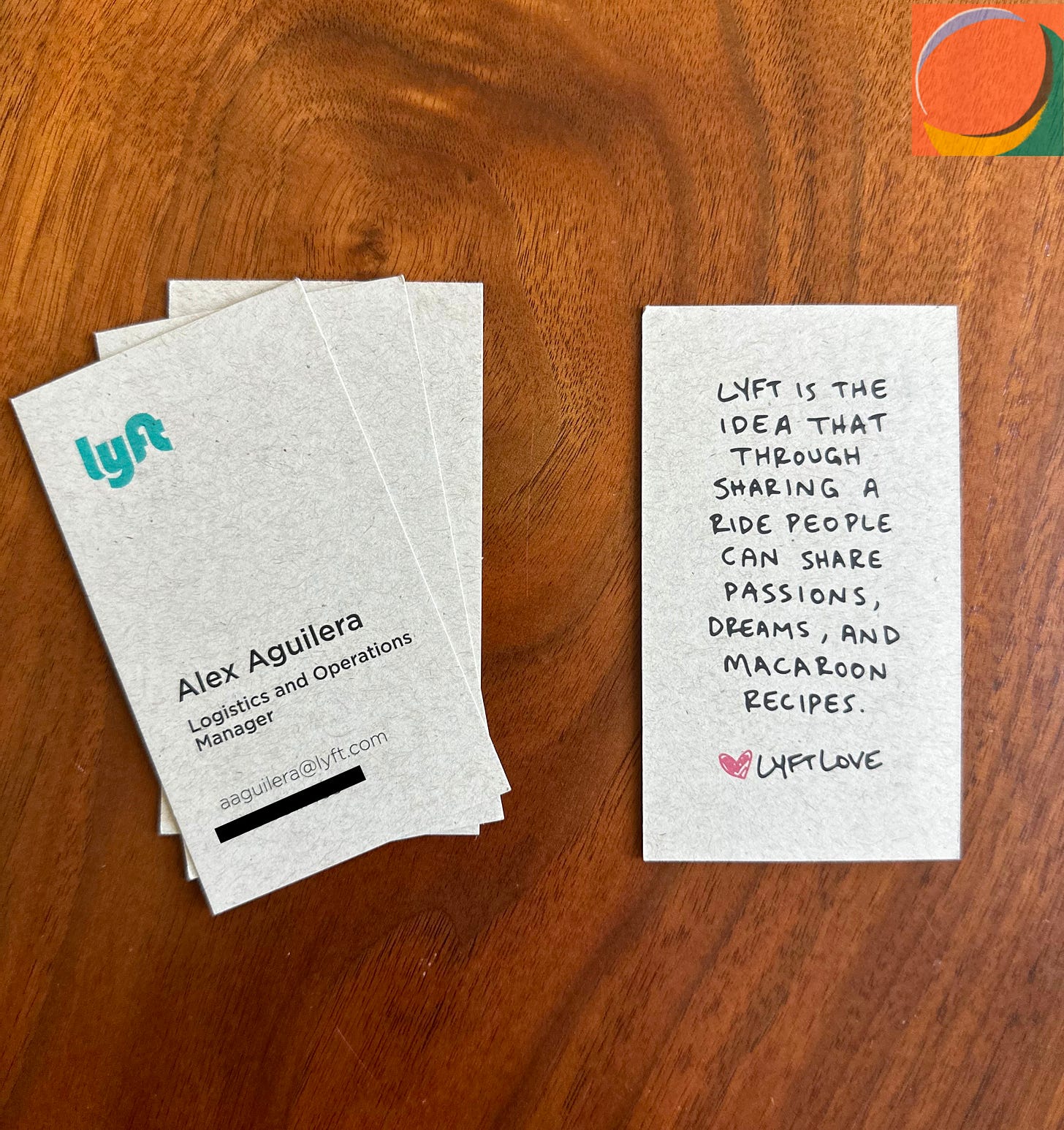Rebel Without a Crew: A Lyft Story – Chapter 3
The Everything Team (Part 1)
"It's better to be a Pirate than join the Navy"
– Steve Jobs
Summer 2013 (continued)
To say things were moving fast was an understatement. The driver funnel was growing by the minute, especially in San Francisco, where word was spreading quickly about the app where you could get paid to give people rides.
Not the Uber one.
The pink mustache one.
It’s funny how quickly people got past the whole “stranger in your car” dynamic when money entered the equation. Gig economy wasn’t a term yet, but the instinct was there. People were embracing the hustle – and Lyft was one of several tech-enabled companies disrupting that paradigm in real time.
Everyone at the company embraced the ambiguity and chaos.
I finally understood the true definition of a fast paced environment.
Sans crew
I sat Steve down. Our meetings were always informal: half hallway catch-ups, half therapy sessions.
“I need to hire someone to help me,” I started.
Steve stroked his beard and eyed me under the brim of his baseball cap like a card player in an old western saloon. His default move when deep in thought.
“We didn’t plan for you to hire any FTEs. We figured you’d manage the operation and eventually outsource a 3PL.”
Side quest: A 3PL (third-party logistics) is a hired vendor that stores, packs, and ships your inventory. No warehouse? No trucks? No problem. They’re the backstage crew of e-commerce – unseen and overworked, but essential. It’s how Amazon can deliver your impulse buys in 2 days or less.
End side quest.
“So like… nobody?” I responded.
Steve likely saw that I was processing it, but the hesitation on my face said what I didn’t.
“No. You can’t hire anyone new.”
Then the classic startup platitude: “You want to scale yourself out of a job.”
I deadpanned: “So you want me to work hard just to be unemployed? Awesome.”
Steve may have missed the sarcasm.
“No dude, you scale your way out, and then we’ll drop you into the next thing. That’s how it works.”
I hated not getting what I wanted when I clearly needed it.
I thought for a moment. “What if I poached someone who already worked here?”
Steve shrugged. “Try it.”
Pitchfest
I pulled Drive Team members aside, took them on quick walks to Blue Bottle, and pitched them on joining me to help build out the operation. I wanted to shake the mailroom vibes I’d been tagged with by those who didn’t understand my work.
No dice.
I approached my buddy Mike Diaz, but he saw me coming. I lied and told him Travis was reassigning him to my team. His brown skin turned pale.
“Bro. Are you kidding me? I can’t go back to manual labor.”
I laughed and came clean. He joked about it, but yeah – he wasn’t leaving his headset behind anytime soon.
Nobody was biting. Not even part-time.
It reminded me of graduate school during my time in the producers program at Chapman University. I pitched an idea for a WWII movie about the true story of a squad of Mexican fighter pilots who supported the U.S. in the Pacific – this was in front of my class to an actual production executive. A few minutes in I could tell that the exec didn’t seem too interested. After, my class filled out feedback cards rating my idea, pitch delivery, and whether they would work with me on any project.
Out of the 24 students, only 2 indicated that they would want to work with me.
No one liked the idea.
That’s show business, baby.
Reinforcements to the Front
Then, a break. One day, a new intern appeared. The type of announcement that happens in real time because someone forgot to give us a heads up.
HQ had airdropped him into the Oakland trenches. His name was Michael Kelleher. Tall, clean-cut, with a bit of Loyola Marymount bro energy. I half-expected some entitlement, but right away, he surprised me: grounded, quick on the uptake, easy to trust. And in no time, he built a reputation as someone who could deliver.
Michael gave me much needed breathing room. He wasn’t afraid to get his hands dirty, and together we built and shipped dozens of kits daily during his stint – 36, 44, 65, 72… and climbing – all on top of any side projects for the team that he could tackle. He was sharp and probably would’ve scaled this operation on his own if I let him.
Michael even came up with the idea for the Lyft Lost & Found program. Drivers were reporting lost items via our new customer support team, and Michael jumped at the chance to build a process: prepaid labels and packaging sent to drivers, a storage locker for returned items (thanks, ULine), reuniting items with passengers when possible, and charity drop-offs for unclaimed stuff.
Not super scalable, but it was on brand.
Wearing All the Hats
As summer went on, my day-to-day evolved as I found more things to tackle. I wasn’t just building and shipping kits – I was unofficially running the Oakland office too. Corey Lambert had just started as Lyft’s official office manager, but he was across the Bay at HQ prepping for our first of many office moves.
While Drive Team members like Amber Cady handled lunch orders for Oakland, I took on everything else: office supplies, Costco and IKEA furniture orders, you name it. Steve handed me his AMEX, the gold one. I guess I was the office manager now – unofficially – and I fully embraced it.
I still felt like an odd duck, but my confidence was growing.
More people were hired. Laptops arrived weekly. Beth Trame had launched Lyft’s customer support and Trust & Safety teams and set up camp in Oakland, making office real estate tighter. Carstache deliveries kept piling up. The wall of pink fur kept growing.
Here’s a picture of a wall we built after one of those deliveries.
August 2013 – Back to School
Michael's internship ended faster than I expected. He seriously considered dropping out to work at Lyft full-time – and a few of us, me included, encouraged him – but saner minds prevailed and convinced him to finish school.
I needed a backup plan. Corey recommended TaskRabbit. He’d hired someone from the platform to build desk chairs around the Oakland office, and people liked the Tasker. I was so busy I hadn’t even noticed them.
This was a great way to get around the no hiring rule. A loophole I planned to fully exploit.
There was so much happening in Silicon Valley at the time – especially in San Francisco – there was an app or platform for everything. I quickly began educating myself on everything I could about these emerging companies. I read TechCrunch, subscribed to tech newsletters and resources like Product Hunt, and even StrictlyVC, which was new in 2013. These helped me understand which companies were launching and getting funded.
I was learning to see the patterns and better understand the ecosystem that was quickly emerging around me.
Enter Shel
Meet Shelbert “Shel” Smith.
Back then, they went by Shelly. They later transitioned, so I’ll be using their current name throughout. Shel was sitting on the floor, listening to music and cheerfully assembling a desk chair. Short hair. Glasses. Loud, electric energy that made them impossible to miss (though clearly I had). A burner. Builder energy. Misfit. Perfect for my team.
We intro’d. I made awkward small talk. Then my Billy Beane moment:
“What are you doing next week?”
I pitched them on helping me scale. They said yes.
One caveat: they’d be out for Burning Man in late August. Fair.
“Cool. See you Monday.”
It was a small win, but it felt like I’d just hit a home run.
A Self-Promotion
The company rolled out business cards for everyone: kraft card stock, Lyft colors, a quirky quote on the back. Classic startup charm.
I have a bunch of these in an old box somewhere.
When HQ asked us all to submit our name, title, and contact info, I stopped.
My title was still officially Shipping Lead.
Fuck that title. I’d outgrown it.
My ego craved something that didn’t put me in a box. But more than that, I needed a title that reflected where I felt I was going: building scalable systems, managing a supply chain, holding the chaos together with duct tape and instinct.
I typed it out:
Logistics & Operations Manager.
I didn’t ask for permission. I just submitted it.
I briefly considered “Director of” or “Head of,” but stopped myself. This wasn’t startup cosplay, it was a signal. I wanted to be seen as the person who made impossible things happen.
Steve noticed. I’d like to think he respected the move: the same way the commander respected Maverick and Goose after they pulled off their MIG stunt… and still sent them to Top Gun.
I now had a TaskRabbit quietly filling the gaps. There would be more. It wasn’t officially sanctioned, but it worked.
And yeah, I borrowed an idea from Uber. Late one night I was scrolling their careers page and saw they had a similarly titled role, Operations & Logistics Managers – these were strategic, data-driven operators powering growth behind the scenes.
Fuck it. I’ll build the Lyft version.
Looking back, that’s when it started clicking for me: the rules are only real if you agree to them.
There’s a quote I once read from Travis Kalanick – Uber’s CEO and our not-so-friendly rival – and the message stuck with me:
“Stand by your principles and be comfortable with confrontation. So few people are, so when the people with the red tape come, it becomes a negotiation.”
I didn’t admire everything about TK’s leadership. But I respected that kind of clarity.
When you’re building something in real time: fast, messy, high-stakes – waiting for permission is just another way to lose.
Man on Fire
Props to Shel: working with me by day, building an installation for Burning Man by night. I admired their side hustle.
I really need to hit up the playa sometime.
Before Shel left, we pre-built a ton of driver onboarding kits to get ahead of the forecast I mapped out – something to lighten my load while I rolled solo that week.
You might be thinking: “Why not hire another TaskRabbit, Alex?”
Damn good question. Part inexperience, part control.
Shel was a talented, unsigned free agent with something to prove. Chip on shoulder. They took ownership from day one. What if the next person didn’t?
I feared the wrong person would come through the door and I’d watch things go sideways.
Visitors
Despite my newfound confidence, it’s worth noting that even a few months into the role I was experiencing regular bouts of imposter syndrome.
Lyft was full of people my age and younger who were gifted, had deep connections in Silicon Valley, graduated from top schools, worked as consultants, or had far more exposure to startup life.
I kept telling myself that I was just a kid from the southside of Stockton.
Word must’ve gotten around that Shel was out and I was riding solo because visitors began trickling into the office.
First, Nick Greenfield dropped by. Confident and sharp – he’d been handling special projects for Lyft and was an original employee of Zimride, Lyft’s predecessor. He wanted to hang out and shadow me for the day.
“You need help around here?” he asked.
Hell yeah.
I played it off like I had everything under control but in reality, I needed help. My original forecast had been a bit off, and without Shel, I was up to my eyeballs with demand.
We chopped it up. I walked him through the kitting process, and my vision for the team.
“Team? But I hear you’re a one-man show.”
“True. But I’m working with Steve and Travis to fund more heads. We’ll be expanding soon.”
Maybe I embellished a little.
I’d gotten so used to pitch-mode, it just rolled out naturally.
Then Nick pitched me on joining my team. I thought he wanted to report to me. But instead, he proposed I run kit building operations while he handled strategy. He casually sprinkled in the fact that he studied international business at Stanford.
My internal eyes were rolling.
For a moment, I thought I was being offered backup. Instead, I was being offered a co-pilot’s seat on my own plane. Impressive resume, but no thanks.
Nick landed fine. He left Lyft not long after to run growth at Washio, another on-demand startup.
Fun fact: Nick later helped me land a job managing the SF/Oakland markets for Washio. He’s now CEO of Candid.
Not long after Nick’s visit, as if on cue, Justin Lyn showed up alone to the Oakland office.
I liked Justin. He was one of those guys you knew probably pissed off his traditional Asian parents more than once.
Case in point: Justin had walked away from a career in law to take a Trust & Safety role on Beth’s customer support team.
It had been a long day. I was overworked, stressed, and suspicious of his visit. It was just me in the office cleaning up one afternoon.
“Hey man, what’s up?” I asked, half interrogating.
“I wanted to help you out. I know you’re a one-man show right now.”
Why did everyone suddenly have an interest in my team?
Customer support had received some anxious emails from onboarding drivers asking where their driver kits were – things were moving fast and people wanted to start making money – he took initiative and visited me in Oakland to lend a hand.
We went back and forth in the middle of the office. Him genuinely offering help, me on the defensive, thinking he too wanted my territory. I can’t recall everything, but I remember:
1) the encounter seemed to leave a bad taste in his mouth, and
2) I quickly realized my error in judgment and felt cringe.
I still feel a little cringe thinking about it today. My bad, Justin.
Years later Justin would return to legal work, including spending several years at Coinbase.
All Systems Are a Go
As Lyft prepped for national expansion, Launchers began leaning on me for support. I was shipping carstaches and available swag for upcoming launches, influencers, local notables, any way to spread the word.
A typical message would look like:
“What do you got in inventory? I need X amount of Lyft swag for [insert city name] ASAP.”
I got special requests which inspired me to research vendors for swag.
Most launchers were fine. A few were pushy.
Then there was Ryan Hupfer – or “Hup.”
Hup joined Lyft, emailed me immediately, and asked for swag:
“I’ll take whatever you got.”
His emails were urgent, but unlike the others, Hup handled comms like a pro. I appreciated it. The approach didn’t feel transactional.
A few days later I heard a commotion in the office and sensed a shadow hovering over me.
“Sup, you Alex?” the voice said.
I looked up. There was a giant white dude towering over my desk. It was Hup. All smiles. We chatted like old friends. He was blowing through town to meet teams before heading into the field. Naturally popular, energetic, gregarious. At 6'6" and 200+ pounds, you noticed when he entered a room.
Fun fact: Remember Myspace? Hup co-wrote Myspace for Dummies. These days he’s founder and CEO of Element Ops.
More with Hup later.
Early Fall – HQ Hot Potato
The first of many organizational shifts hit like a ton of bricks. Drive Team and customer support, both based in Oakland, were relocating to a new office in San Francisco at 185 Clara Street.
Steve mentioned the Oakland lease was still active.
“It’s all yours,” he said.
4,000 square feet. All mine.

The move happened fast. Corey was a beast – coordinating with multiple vendors for moves across multiple offices. The new office was big enough to house the growing company.
Everyone but me.
A part of me embraced the opportunity. Like a teenager left home alone for the weekend: part freedom, part paranoia. A part of me experienced a serious case of FOMO. I worried about being alone on this side of the bay and the company blowing up without me.
Moving boxes showed up, movers followed, and soon the office was mostly gutted – except for my desk, some furniture, and the mostly intact corner office that Steve and Travis used.
And just like that, operations carried on.
Then I got a ping from Elliot Henrikson.
“Don’t cry, motherfucker. We’re setting up a desk for you at HQ for when you stop by 🙂”
I loved my team.
And I made it a point to stop by the new HQ every week.
CUT TO BLACK
🎧 Cue “Hustle and Cuss” – The Dead Weather
Listen on Spotify | Watch on YouTube
Know someone who’d appreciate this story? Feel free to share it – the more the merrier :)
Previous post: Rebel Without a Crew: A Lyft Story – Chapter 2 – Unfuck Everything
Next stop: Chapter 4 – The Everything Team (Part 2) Coming Soon




